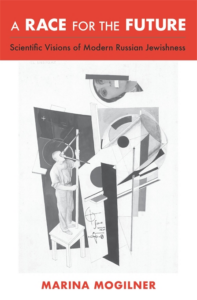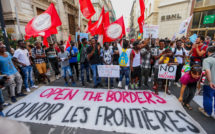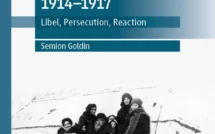

Proponents of a variety of nineteenth-century movements and activists claimed that Jews were a people (the Zionist movement) or a religious group (Agudas Israel). The same period also saw the rise of eugenics, which encouraged scientists and doctors to analyze Jews medically, in an approach that included racial overtones (and often outright assertions) and culminated in twentieth-century Nazi race theory. Jews themselves also participated in the discourses advancing Judaism as a race. Some German-Jewish doctors, for example, built a racialized language of Jewishness in the nineteenth and early twentieth centuries, sometimes quite amusingly, as in their analysis of Jewish fitness to serve in the army based on the “weakness” of Jewish feet.[1] However, did Jews in the Russian Empire, home to the largest Jewish population during that period, also participate in the building of this racialized language? In A Race for the Future: Scientific Visions of Modern Russian Jewishness, Marina Mogilner proves that they did. Rather than focusing on the well-worn paths of Jewishness as a culture (as trod by Kenneth Moss, say, in Jewish Renaissance in the Russian Revolution), or as a nation (as trod by Simon Rabinovitch in Jewish Rites, National Rites) within the Russian Empire, Mogilner examines the ideas surrounding Jewishness as a race.[2] Mogilner makes a tremendous contribution to the understanding of the “Jewish Question” in the nineteenth century in this thoroughly researched and fluidly written volume.
The first part of the book covers the study of race during the time of the Russian Empire and the ways in which three leading Russian Jewish scientists— Samuel Weissenberg, Arkadii El’kind, and Lev Shternberg—engaged in this study. On the one hand, Weissenberg came to study the scientific basis for race as a physician working with the Jews of Elisavetgrad, who provided him with an unlimited supply of bodies on which to take measurements. He concluded that Jews were “Caucasians”—literally “transformed during their sojourn in the Caucasus”—making them one of the “mixed race” Indigenous peoples of the Russian Empire (49). Weissenberg was, Mogilner argues, able to draw these conclusions through the language of German anthropology, the Russian imperial context, and Russian Jewish science. Also a physician by training, El’kind, on the other hand, believed in Jewish racial distinctiveness. Mogilner argues that that scholar was driven by the need to “normalize Jewish science”—i.e., the need to include Jews in the modern scientific project (74). El’kind collected anthropometric statistics from Jews working at factories in Warsaw, which led him to claim that although Jews had been involved in some racial mixing, it had not been substantial enough to strongly affect them racially. However, Shternberg (who appears in Francine Hirsch’s Empire of Nations) was the only officially designated ethnographer out of the three Russian Jewish scientists presented in the book. In an attempt to transcend his Jewishness, he sought to make it into an acceptable imperial academic study based on his standing as a leading imperial ethnographer (he would eventually become a member of the Russian Academy of Sciences in the USSR). An undercurrent in all three stories is the tortuous belief that “something [is] wrong with the Jews.” The study of Jews as members of a race was meant to bring them into modernity, whether by rooting them in the Russian Empire, normalizing the study of Jewishness, or determining the biological problems they faced.
The second part of the work examines the racialization of Jews as a “subaltern form” of politics, as Jews looked out for their own in the wake of “wars, pogroms, and famine” (158). In 1910, members of the Jewish Physicians Circle, for example, sought to “forg[e] a healthy, biologically ‘normal,’ modern Jewish nation” (164). Such ideas coalesced in such journals as Jewish Medical Voice and organizations such as the Society for the Protection of the Health of the Jewish Population, which represented a program of “biological self-improvement” (173). As Jewish physicians streamed into specifically Jewish medical societies, they naturally concerned themselves with the “functioning of the Jewish national organism,” which, in turn, necessitated statistics and nationality-based surveys of Jews (183). Mogilner argues that this “language of medical statistics” helped usher Russian Jews into a rational, objective modernity. This effort was later invigorated out of a necessity to care for Jewish victims of WWI and the Civil War. In the Soviet period, the racialized idea of Jewishness was utilized in efforts to reforge Jewish bodies into true proletarian ones using physical labor. Such focus on Jewish bodies suggests that the belief that “something is wrong with the Jews” penetrated the political efforts of science activists who advanced the idea of a Jewish race long after the tsarist regime had collapsed.
Ultimately, Mogilner considers the Jewish-ization of race as a “scientifically sound and politically effective answer to th[e] predicament of inescapable historicity, a remedy for being defined in terms of a lack” (5). Jews across the Russian Empire—from the Jews in the mountainous areas of the North Caucasus to the Jews of Poland examined by El’kind—lacked a common language, territory, or culture. Race, then, could bring them together, and, in so doing, distinguish them from the rest of the Russian population. Mogilner claims that “the Russian engagement with ‘race’ is interpreted as an anticolonial strategy for establishing national ‘authenticity’ and safeguarding it from colonial domination attributed to the Russian Empire” and beyond (6).
This story of Jewish race science doubly (or triply) situates Jews within European imperial modernity. First, activists and scientists engaged in the broader European project of race science. Next, they used it to “perform collectively like a nation-state without having any Jewish state back their efforts” (158). All these considerations, which Mogilner could have explored in greater depth, situated Jewish race science and biopolitics within the broader “Jewish problem.” Indeed, efforts had to be made to fix the fundamental problems of the Jews, whether through the organization of lectures on the topic of “Nervous and Mental Illnesses Among Jews, Their Origin and How to Fight Them” or through agricultural settlements (the mission of OZET, the Society for Settling Toiling Jews on the Land, for example).
Mogilner might have done more, however, to explain the connections between this Jewish racial movement and contemporary cultural, national, or even religious movements. While race was one way to unify Jews in the Russian Empire, it was not the only way. Rabinovitch, for example, examines the movement for Jewish autonomy led by Simon Dubnow (Mogilner does admittedly examine Dubnow’s views on race.) This movement emanated from a belief in Jews’ historical evolution as members of a nation, which was rooted in the now-dissolved kehila. Dubnow offered an alternative “politically effective answer to this predicament of inescapable ahistoricity,” much like Mogilner’s race scientists (5). In fact, Dubnow may have been trying to solve this very dilemma by returning Jews to their distinctive historical form of self-government to maintain their distinctiveness. Moss also paints a picture of Russian Jews in the face of similar issues. Contemporaries of El Lissitzky (whose “Tatlin at Work” is on the cover of Mogilner’s book) worked in the Kyiv-based Kultur-Lige and Moscow-based Tarbut to bring Jews together under the umbrella of a Jewish high culture; in so doing, these scholars sought to bring Jews into the broader European teleology that led a movement toward enlightenment and “world” literature. Not unlike Jewish race scientists, these scholars attempted to solve the problem of Jewish “ahistoricity” by aligning the path of Jewish cultural development with the broader European path. They also advocated for Jewish culture beyond the “colonial domination” of Jews and Jewish culture within the Russian Empire by creating that culture in non-Russian languages, in broader European cultural styles, and, not least, in places beyond the Pale of Settlement, the region of the Russian Empire open to Jewish settlement.
Mogilner is certainly not denying the developments that Moss or Rabinovitch detail, but the concept of a Jewish race was hardly the only idea to grapple with over the issues of Jewish ahistoricity, national disunity, or the “interventionist national state.” Race was but part of the intellectual ferment of the greater nineteenth and twentieth centuries surrounding the status of Jews in the Russian Empire. Mogilner does a great service to the field in shedding light on Russian-Jewish race science, but her work might have been strengthened if she acknowledged more widely the broader intellectual environment surrounding the development of Russian Jewish race science. In other words, how did ideas of Jewish cultural and political development affect the course of Jewish race science in the Russian Empire? What influence did ideas of Jewish politics and culture have on the scientists who studied Jewish bodies?
Perhaps the book’s most remarkable contribution is in the intellectual history of the Russian Jewry. Indeed, Mogilner’s deep analysis of Shternberg’s, El’kind’s, and Weissenberger’s ideas—as well as the ways in which these ideas were received and implemented by a variety of constituencies—is a crucial addition to our understanding of how people in the Russian Empire—and later the Soviet Union—saw both Jews and race. Hence, her book constitutes a prehistory of the ideas that the imperial-turned-Soviet ethnographers, who are described in Francine Hirsch’s Empire of Nations, developed as they consolidated the former Russian Empire’s various groups of Jews into one nationality in the time between the first Soviet census that took place in 1926 and that of 1940.[1] Mogilner’s book allows us to illuminate some connections between the Jewish “racial” work of old and the Jewish national project of the USSR. Even if she claims that “[Jewish socialist] activists… preferred economic, political, or cultural idioms of Jewishness to the language of biological race,” I cannot help but wonder if the work of the scientists and physicians she analyzes, such as El’kind, later influenced ethnographers to eventually categorize the varied Jews of the USSR as belonging to one Jewish nationality. Mogilner has laid an excellent beginning to the study of Jews as a race in the Russian Empire and written a superb book in its own right, one that I hope will become necessary reading in most courses on Jewish thought of the Russian Empire and USSR.
Leora Eisenberg is a second-year PhD student in Russian and East European History at Harvard University. She studies the production of national culture, interethnic relations, and Jewish history in Soviet Central Asia.
A Race for the Future: Scientific Visions of Modern Russian Jewishness
By Marina Mogilner
Publisher: Harvard University Press
Hardcover / 352 pages / 2022
ISBN: 9780674270725
[1] Francine Hirsch, Empire of Nations: Ethnographic Knowledge & the Making of the Soviet Union, Culture and Society after Socialism (Ithaca, N.Y.: Cornell University Press, 2005).
[1] Sander L. Gilman, The Jew’s Body (New York: Routledge, 1991), 40.
[2] Kenneth B. Moss, Jewish Renaissance in the Russian Revolution (Cambridge, Mass.: Harvard University Press, 2009); Simon Rabinovitch, Jewish Rights, National Rites: Nationalism and Autonomy in Late Imperial and Revolutionary Russia, Stanford Studies in Jewish History and Culture (Stanford, California: Stanford University Press, 2014).
Published on May 1, 2023.




